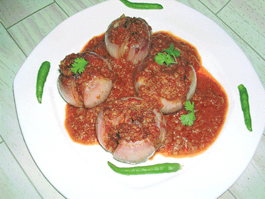|
Food Talk
Know your onions
A must for both vegetarian and
non-vegetarian fare, onions seldom occupy the centrestage, observes Pushpesh Pant
 Good
old onions do their best to serve us. They are the base of most of the
gravies, providing body, if not the soul, to countless dishes both
vegetarian and non-vegetarian. Historians tell us that onions originated
in North Asia and have been grown for more than 5000 years. Scientists
have discovered that they have a very few calories and are a rich source
of sulphur. The French swoon over their French onion soup and cordon
bleu chefs wax eloquent about it. Good
old onions do their best to serve us. They are the base of most of the
gravies, providing body, if not the soul, to countless dishes both
vegetarian and non-vegetarian. Historians tell us that onions originated
in North Asia and have been grown for more than 5000 years. Scientists
have discovered that they have a very few calories and are a rich source
of sulphur. The French swoon over their French onion soup and cordon
bleu chefs wax eloquent about it.
Only the strictest of the shaakahari
eschew the beautifully pungent bulbs and perhaps with the exception of
the potato, no other vegetable can claim to be the darling of the not-so
affluent. Pyaaz ke saath roti khana is just a little bit better
than making do with salt. The best is that you donít even have to cook
the onions. Muthmaar pyaaz transports even the mundane rustic
fare to sublime. The wonderful crunch of raw onions is greatly valued
even by the gourmet. No self-respecting dhaaba can ever skip the sirkewale
pyaaz. And, can you imagine saambar without the pearl like
Madras onions?
The price of onions has
long been considered ó at least in India ó the best index of
inflation and a spiraling increase has brought down a government in the
nationís Capital in the recent memory. Not knowing your onions is
synonymous with unpardonable ignorance.
What is intriguing is that
seldom are the onions given their due. There are the pakoda and bhajiya
and the pyaaz ki kachori but that does not seem to do justice.
They are visible in salads, garnishes or tempering, even as sidekicks in
fillings humbly stretching a more aromatic and expensive masala
but never allotted to occupy centrestage. Well, almost never.
In Rajasthan, where greens
are scarce, and fresh veggies till recently were expensive, the denizens
of the desert gratefully acknowledge their debt to this "available
year round" friend and treat themselves, and guests, to kandhe
ki subzi where pyaaz is the star and not a mere accompanist.
|
Kandhe ki sabzi |
|
Ingredients
Onions 1/2 kg
Coriander powder 1 tbsp
Cooking oil 3 tbsp
Turmeric powder 1/2 tsp
Cumin powder 1 tsp
Red chilli powder 1 tsp
Garlic paste 4 tsp
Ginger paste 2 tsp
Tomatoes (chopped) 250gm
A pinch kasoori methi (crushed)
Green chillies (slit) two
The filling
Amchoor/mango
powder 1 tsp
Coriander powder 1 tsp
Cumin Powder 1 tsp
Red chilli powder 1/2 tsp
Turmeric powder 1/2 tsp
A pinch of black rock salt
Sugar (optional) 1/2 tsp
Salt to taste
|
Method
Peel, wash and
make criss-cross incisions on top of the onions for filling.
Prepare the filling by mixing all ingredients listed under this
head. Pack equal quantities of the filling between the incisions
in the onions and reserve for 30 minutes.
Heat oil in a pan, add
cumin, stir over medium heat until the seeds begin to splutter,
add garlic and ginger pastes, stir-fry until the moisture
evaporates, add green chillies and stir-fry for about a
minute. Then add coriander, red chilies and turmeric (all
dissolved in 3tbsp of water), stir for a minute, add tomatoes and
stir-fry until the tomatoes are completely mashed. Now
gently place the onions filled with spice paste in the pan with
salt, stir, reduce to low heat, cover and cook, stirring
occasionally, until the onions are soft, but not squishy. Sprinkle
kasuri methi, stir, remove and adjust the seasoning. |
|